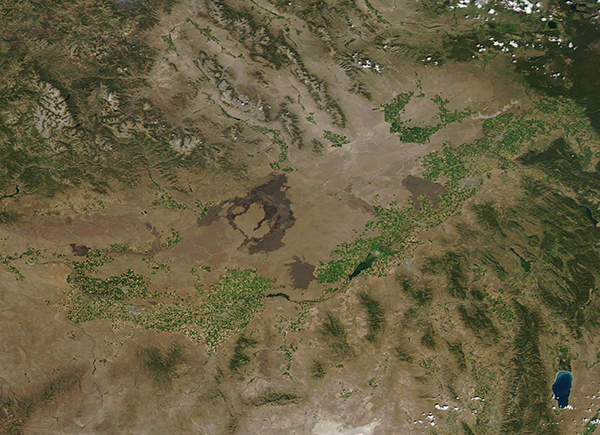Images
July 27, 2022 - Lava Fields in Snake River Plain, Southern Idaho
Tweet
At first glance, the land adjacent to Idaho’s portion of the Snake River appears to be a wide, dry floodplain, similar to floodplains found near most rivers. However, a longer looks reveals curious features that expose the volcanic origins of the Snake River Plain.
On July 25, 2022, the Moderate Resolution Imaging Spectroradiometer (MODIS) on board NASA’s Aqua satellite acquired a true-color image of the eastern Snake River Plain.
The most curious feature visible is a large, dark area near the center of the image. From space it gives the appearance of a giant can of ochre paint spilled across the landscape, creating quite a mess. In fact, the dark colors mark a “weird and scenic landscape” that is a “vast ocean of lava flows with scattered islands of cinder cones and sagebrush,” according to the National Park Service’s website as they describe this unique portion of the Craters of the Moon National Park and Monument.
The Craters of the Moon lava field is a striking area of recent volcanic activity containing 60 (or more) lava flows, each ranging from approximately 15,000 to 2,100 years old. Together the flows cover 1,600 square kilometers (620 square miles) with a total volume of 30 cubic km (7.2 cubic miles). Several other lava fields are also found within the Snake River Plain, including the Wapi Lava Field that sits southeast of Craters of the Moon. Another large field, called Hell’s Half Acre Lava Field, sits to the northeast and is bordered by green scrubby vegetation that grows near the course of the Snake River.
Although the Snake River Plain appears much like it was created by an ancient meander of the river, the presence of lava fields point to a much more violent origin. Millions of years ago, the plain formed as the North American Plate pushed over a stationary mantle plume (“hotspot”) in the Earth’s crust. The North American Plate continues to crawl slowly along, roughly moving about 4.5 millimeters a year over the hotspot, and this motion has resulted in a linear track of volcanism that parallels the motion of the plate, which is quite evident in the volcanic features found in the eastern Snake River Plain. Today, the hotspot fuels the famous geysers found in Yellowstone National Park.
Image Facts
Satellite:
Aqua
Date Acquired: 7/25/2022
Resolutions:
1km (231.7 KB), 500m (637.1 KB), 250m (422.4 KB)
Bands Used: 1,4,3
Image Credit:
MODIS Land Rapid Response Team, NASA GSFC
Tweet
At first glance, the land adjacent to Idaho’s portion of the Snake River appears to be a wide, dry floodplain, similar to floodplains found near most rivers. However, a longer looks reveals curious features that expose the volcanic origins of the Snake River Plain.
On July 25, 2022, the Moderate Resolution Imaging Spectroradiometer (MODIS) on board NASA’s Aqua satellite acquired a true-color image of the eastern Snake River Plain.
The most curious feature visible is a large, dark area near the center of the image. From space it gives the appearance of a giant can of ochre paint spilled across the landscape, creating quite a mess. In fact, the dark colors mark a “weird and scenic landscape” that is a “vast ocean of lava flows with scattered islands of cinder cones and sagebrush,” according to the National Park Service’s website as they describe this unique portion of the Craters of the Moon National Park and Monument.
The Craters of the Moon lava field is a striking area of recent volcanic activity containing 60 (or more) lava flows, each ranging from approximately 15,000 to 2,100 years old. Together the flows cover 1,600 square kilometers (620 square miles) with a total volume of 30 cubic km (7.2 cubic miles). Several other lava fields are also found within the Snake River Plain, including the Wapi Lava Field that sits southeast of Craters of the Moon. Another large field, called Hell’s Half Acre Lava Field, sits to the northeast and is bordered by green scrubby vegetation that grows near the course of the Snake River.
Although the Snake River Plain appears much like it was created by an ancient meander of the river, the presence of lava fields point to a much more violent origin. Millions of years ago, the plain formed as the North American Plate pushed over a stationary mantle plume (“hotspot”) in the Earth’s crust. The North American Plate continues to crawl slowly along, roughly moving about 4.5 millimeters a year over the hotspot, and this motion has resulted in a linear track of volcanism that parallels the motion of the plate, which is quite evident in the volcanic features found in the eastern Snake River Plain. Today, the hotspot fuels the famous geysers found in Yellowstone National Park.
Image Facts
Satellite:
Aqua
Date Acquired: 7/25/2022
Resolutions:
1km (231.7 KB), 500m (637.1 KB), 250m (422.4 KB)
Bands Used: 1,4,3
Image Credit:
MODIS Land Rapid Response Team, NASA GSFC




